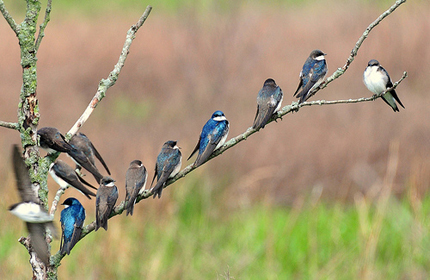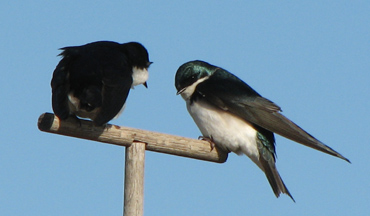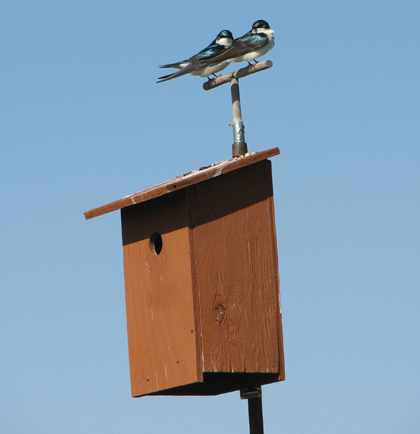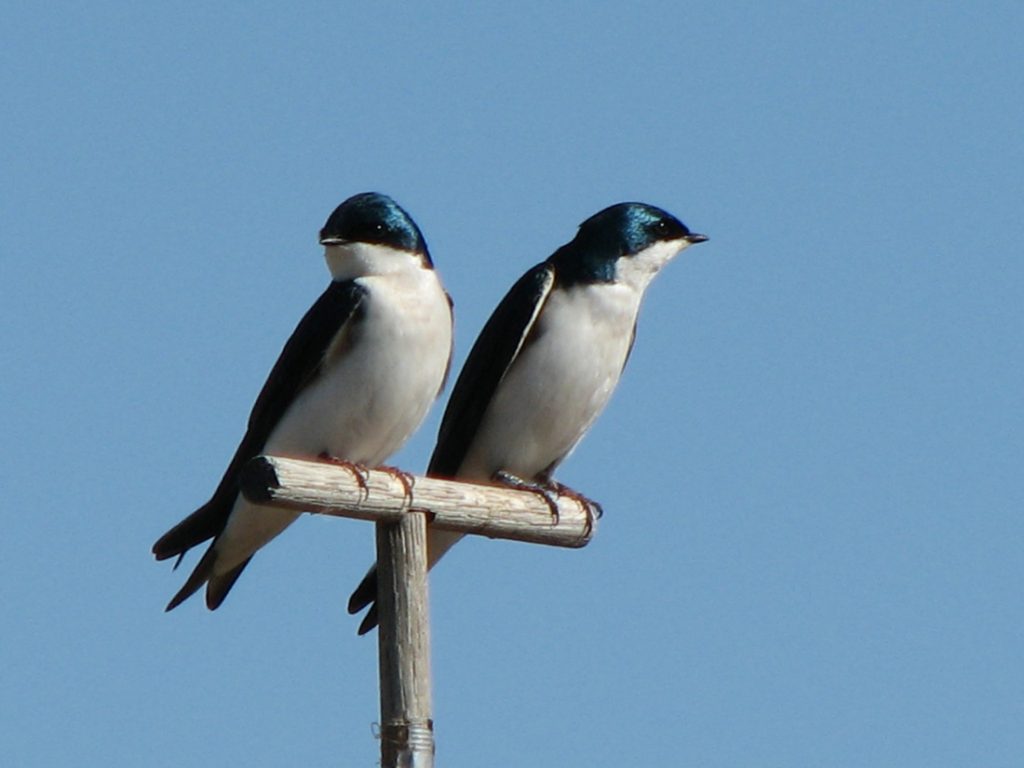At Your Boxes:
There’s still lots of commotion around the nest boxes. If anything it’s increasing because, in addition to box claiming, Tree Swallow courtship and pair formation are underway. Plus, to add to the chaos, young second-year swallows, last year’s nestlings that migrate north two to four weeks after older birds, are arriving now. The group of younger birds in Ed Craft’s photo below reached Indiana in early May, well after the older Tree Swallows had returned.

Note the plumage differences in these birds. You can’t distinguish second-year male Tree Swallow from older males because all breeding age males have bright blue upper bodies. To complicate things even more, older, after-second-year (ASY) females have the same blue plumage as males! But only second-year (SY) females have mostly brownish upper bodies and heads. So, of the 11 perched birds in the photo above, 9 are brownish SY females with varying amounts of blue. The other two blue birds are either SY males, ASY males, or ASY females, we can’t tell which! Here’s a link to our page on the confusing subject of Sexing and Aging Tree Swallows.
If this is your project’s first year, a majority of your swallows may be SYs that have never nested before and were scouting for unclaimed nest sites. In older, well-established projects you can expect more older birds returning to sites where they nested before, and a lower percentage of brownish SY females.
Concepts:
Although we may have trouble telling their sexes apart, the Tree Swallows have no such difficulty. Somehow, despite all the commotion of box claiming, Tree Swallow courtship and pair formation occurs. And it happens fast, probably because both male and female are in a hurry. They must find a nest site as soon as possible and defend it from all rivals.
What is courtship and what are its purposes in pair formation?
- Courtship is the set of special vocal and physical displays a bird uses to signal others of that bird’s species of its sex, its “quality,” and that it is ready and willing to reproduce.
- These displays are crucial in helping potential pair members overcome mutual hostility and fear, so they can form pair bonds.
- Courtship also helps synchronize the internal physical reproductive states of the pair, and stimulates later stages of nesting.
Why would males and females that need to find a mate be hostile to one another or afraid of each other during courtship and pair formation?
- Aggression, fear, and sexual motivation to breed are all part of pair formation.
- Many, if not most songbirds act strictly as individuals at other times of the year. But during the nesting season they must partner with individuals of the opposite sex in order to reproduce.
- To form pairs the two birds must overcome instincts to act aggressively or to flee from the other when the other approaches or is present.

- Courtship displays help defuse these hostile or fearful feelings and actions.
- Once the male and female get to “know” each other tensions of mutual hostility and fear fade away. They become used to the other’s presence and tolerate it with a minimum of friction.
What is a typical sequence of events in Tree Swallow courtship and pair formation?
- Males must successfully claim a nest cavity first, because females seldom pair with males that lack this crucial resource.
- Males display and call to point their cavity out to passing females.
- Females that approach may receive a hostile response from the males at first, the same they would give to repel intruding males.
- Females that are really interested must overcome their fear and return, giving displays identifying themselves as females, which pacify the males.
- Once the male recognizes a particular female as a non-threatening individual and a potential mate his hostility lessens. Then the two can begin to use other displays to cement their pair bond.
How can you tell that courtship and pair formation have been successful and a pair is established at a box?
- You will see two swallows perched peacefully together at a box, defending it.
- Males mainly defend against other intruding males, while females defend against intruding females.

What does a male Tree Swallow “want” or “look for” in a female?
- A mate that is “good at being a Tree Swallow.” In other words a female that demonstrates by her behavior and physical attributes that she has the right combination of genes and experience for keeping herself alive and reproducing successfully.
What does a female Tree Swallow “want” or “look for” in a male?
- The same that males want: a mate with the genes and experience for keeping himself alive and reproducing successfully.
Therefore, Tree Swallows, like other birds, must be able to assess potential partners and “recognize” genetically-based “quality.”
What happens if a “less fit” partner is accepted, one that isn’t so good at Tree Swallow life skills or at reproducing?
- Swallows that choose inferior mates may leave fewer descendants.
- Leaving descendants is the one and only reason for nesting, or existing for that matter.
How can females “recognize” good males?
“Good” males:
- Usually possess nest sites (but not always, as we will see).
- Show they can keep possession of nest sites by vigorous defense against other males.
- Show strong, agile flight during chases.
- Have healthy plumage.
- Use proper songs, calls, and displays to attract females so females can gauge their qualities.
- Show less evidence they are infested with parasites.
How can males “recognize” good females?
“Good” females:
- Vigorously defend nest sites against other females.
- Show strong, agile flight during chases.
- Have healthy plumage.
- Respond properly to male courtship behaviors.
- Initiate proper female courtship behaviors.
- Show less evidence of parasites.
Some Tree Swallow nest site claiming behaviors are also used in courtship and pair formation. Such dual purpose behaviors include:
- Chatter Call: Females will not pair with a male unless he possesses a nest site. Chatter calls are given by males to encourage females to come look at their sites. This call seems to proclaim “I’m tough and strong. I’ve claimed a nest site and defended it. Come check it out.”
- Perching at Hole: Males often perch at entrance holes, chattering and fluttering their wings, pointing the cavity out to passing females.
- Chasing Another: Males may chase females and vice versa. This allows potential pair members to display their flying abilities.
- You can see dual purpose behaviors used in both competition for nest sites and pair formation in this video.

Some other behaviors seem just for courtship and pair formation. They aren’t as common as those listed above but you may see:
- Gaping: Both male and female swallows will gape, open-mouthed (see above), when the another swallow’s nearness stimulates feelings of hostility and fear. Gaping may help defuse tension caused by these feelings, allowing a male and female to tolerate each other’s presence.
- Vertical Posture: Male perches on box with body and head held steeply upright with bill pointed skyward.
- Courtship Pounce: Female response to male’s Vertical Posture. Female approaches perched male and displaces him, perching in his former spot. Male may then Perch at Hole and Chatter.
- Bobbing and Billing: Perched pairs face each other, bobbing heads up and down, sometimes making contact with their bills.
All the above behaviors may be involved in courtship and pair formation. Plus, there are undoubtedly other, more subtle behaviors that are hard for us to see and recognize.
Be aware that pairs once formed may be broken:
- One member can die or desert.
- Resident males or females can have their nest sites taken by other swallows.
- Watch for desertions and takeover attempts. They may occur quickly and without much warning.
Also be aware that about 5% of males in multi-box project grids successfully claim more than one nest box. They may pair with two females, one at each box.
- This may be advantageous for males, who can potentially father more young.
- However, if a male successfully claims two nest sites and has a female and young in both, he usually concentrates his feeding efforts at one nest only, especially as the young get older.
- Then the burden of feeding young at the other nest falls mostly or entirely on its female. In these cases it has been found that fewer young are usually produced because it’s difficult for just one parent to supply the necessary food.

Questions for the next Topic: Nest Building in Tree Swallows.
- What is the purpose of a nest? Why have one?
- Have the Tree Swallows finished building their nests?
- If they haven’t finished, or have barely started, what’s taking them so long?
——————————————————————————–
Home: Tree Swallow Nest Box Projects
Creating Tree Swallow Nest Box Projects
Spring Return
Nesting Season Behavior
Song and Calls
Nest Site Claiming
Pair Formation
Nest Building
Bird Flight
Mating and Paternity
Diary of One Season at Salmon Creek
Monitoring Nest Boxes and Keeping Records
Making Box Checks Keeping Box Records Control Sheets Season Summaries Print Sheets
Banding Your Tree Swallows Banding Adults Banding Nestlings
Tree Swallows in Research Research Bibliography Glossary of Terms